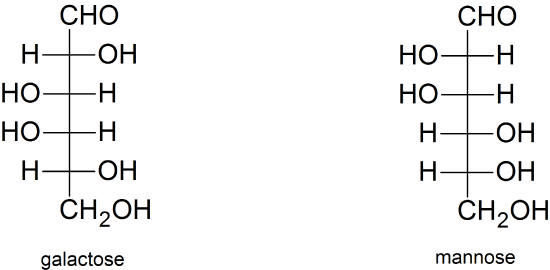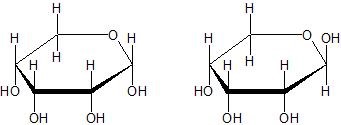14: Carbohydrates (Structure and Function): Questions
- Page ID
- 43928
Carbohydrate Structure
(01) Study the following Fischer projections to answer the questions below.

- Is galactose a D-sugar or an L-sugar?
- Is mannose a D-sugar or an L-sugar?
- Choose either one, and sketch it as it would appear if it was an L-sugar.
- Are these two carbohydrates enantiomers? If not, in how many places do they differ?
- What is the term to describe the relationship between galactose and mannose?
(02) Are any of the following carbohydrates L-sugars? What makes something an L-sugar as opposed to a D-sugar? Rewrite each structure into an L-sugar if they are not already in that conformation.

(03) Which carbon is considered the anomeric carbon? How do you distinguish between the alpha and beta types of anomers?
(04) Study these Haworth projections to answer the following for each of them.


- Is it a furanose or a pyranose?
- Is it an alpha or beta anomer?
- Circle the anomeric carbon.
(05) Examine the structure of this Fischer projection of D-gulose.

- Number each carbon from 1 to 6. What number is the anomeric carbon?
- Circle the –OH group that determines whether it is a D- or L-sugar.
- Sketch the structure of L-gulose for comparison. Are the two versions of gulose enantiomers of one another or diastereomers?
- Now sketch the structure of D-glucose for comparison. Are D-gulose and D-glucose enantiomers or diastereomers?
(06) Examine the following Haworth projections to answer the questions below.

- Circle each anomeric carbon
- Which of the two is the alpha anomer and which is the beta anomer?
- Are these structures considered enantiomers or diastereomers?
- Are these monosaccharides reducing sugars? Explain.
- Can you convert the alpha anomer to a beta anomer? Explain.
(07) Consult your text and notes for the structure of lactose. Lactose utilizes a beta-1,4 linkage to form a disaccharide. Sketch a hypothetical disaccharide where it instead links the two monosaccharides that form lactose via an alpha-1,6 formation.
(08) Some people cannot digest the disaccharide lactose. The term for this is known as lactose intolerance. Lactose is shown below. Answer the following questions.

- What is the name of the enzyme that would be required for someone to be able to digest lactose?
- Classify lactose as a mono-, di-, oligo-, or polysaccharide.
- Label anomeric carbons by circling them. Is lactose a reducing sugar?
- Draw an arrow pointing to the glycosidic bond. Is the glycosidic bond connected to both anomeric carbons?
- Classify the glycosidic bonds using the alpha or beta-(#,#) format.
- If the glycosidic bond is hydrolyzed, what are the names of the monosaccharides produced. Remember to include the alpha or beta classification for the anomeric carbon.

